Krakatoa
Krakatoa, or Krakatau (Indonesian: Krakatau), is a caldera[2] in the Sunda Strait between the islands of Java and Sumatra in the Indonesian province of Lampung. The caldera is part of a volcanic island group (Krakatoa Archipelago) comprising four islands: two of which, Lang and Verlaten, are remnants of a previous volcanic edifice destroyed in eruptions long before the famous 1883 eruption; another, Rakata, is the remnant of a much larger island destroyed in the 1883 eruption.
| Krakatoa | |
|---|---|
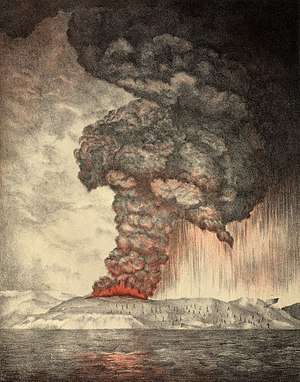 An 1888 lithograph of the 1883 eruption of Krakatoa | |
| Highest point | |
| Elevation | 813 m (2,667 ft) |
| Prominence | 813 m (2,667 ft) |
| Listing | Spesial Ribu |
| Coordinates | 6°06′07″S 105°25′23″E |
| Naming | |
| Native name | Krakatau (Indonesian) |
| Geography | |
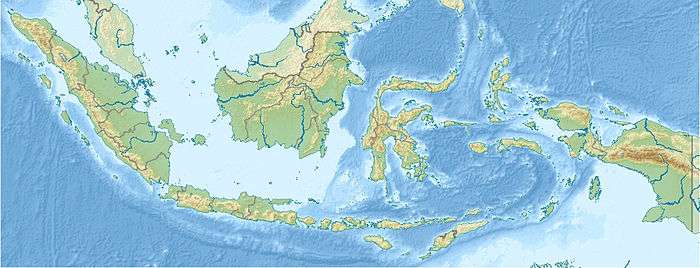 Krakatoa Location within Indonesia | |
| Location | Indonesia |
| Geology | |
| Mountain type | Caldera |
| Last eruption | 2020[1] |
In 1927, a fourth island, Anak Krakatau, or "Child of Krakatoa", emerged from the caldera formed in 1883. There has been new eruptive activity since the late 20th century, with a large collapse causing a deadly tsunami in December 2018.
Historical significance
The most notable eruptions of Krakatoa culminated in a series of massive explosions over 26–27 August 1883, which were among the most violent volcanic events in recorded history.
With an estimated Volcanic Explosivity Index (VEI) of 6,[3] the eruption was equivalent to 200 megatons of TNT (840 PJ)—about 13,000 times the nuclear yield of the Little Boy bomb (13 to 16 kt) that devastated Hiroshima, Japan, during World War II, and four times the yield of Tsar Bomba, the most powerful nuclear device ever detonated at 50 Mt.
The 1883 eruption ejected approximately 25 km3 (6 cubic miles) of rock.[4] The cataclysmic explosion was heard 3,600 km (2,200 mi) away in Alice Springs, Australia, and on the island of Rodrigues near Mauritius, 4,780 km (2,970 mi) to the west.[5]
According to the official records of the Dutch East Indies colony, 165 villages and towns were destroyed near Krakatoa, and 132 were seriously damaged. At least 36,417 people died, and many more thousands were injured, mostly from the tsunamis that followed the explosion. The eruption destroyed two-thirds of the island of Krakatoa.
Eruptions in the area since 1927 have built a new island at the same location, named Anak Krakatau (which is Indonesian for "Child of Krakatoa"). Periodic eruptions have continued since, with recent eruptions in 2009, 2010, 2011, and 2012, and a major collapse in 2018. In late 2011, this island had a radius of roughly 2 kilometres (1.2 mi), and a highest point of about 324 metres (1,063 ft) above sea level,[6] growing five metres (16 ft) each year.[7] In 2017, the height of Anak Krakatau was reported as over 400 m (1,300 ft) above sea level;[8] following a collapse in December 2018, the height was reduced to 110 meters (361 ft).[9][6]
Etymology
Although there are earlier descriptions of an island in the Sunda Strait with a "pointed mountain," the earliest mention of Krakatoa by name in the western world was on a 1611 map by Lucas Janszoon Waghenaer, who labelled the island "Pulo Carcata" (pulo is the Sundanese word for "island"). About two dozen variants have been found, including Crackatouw, Cracatoa, and Krakatao (in an older Portuguese-based spelling). The first known appearance of the spelling Krakatau was by Wouter Schouten, who passed by "the high tree-covered island of Krakatau" in October 1658.[10]
The origin of the Indonesian name Krakatau is uncertain.[11]
The Smithsonian Institution's Global Volcanism Program cites the Indonesian name, Krakatau, as the correct name, but says that Krakatoa is often employed.[7][12][13]
Geographical setting
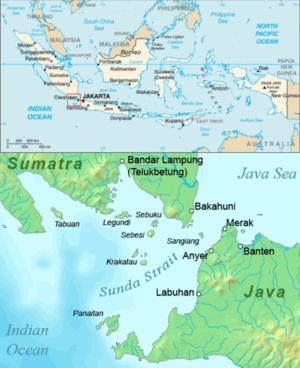
Indonesia has over 130 active volcanoes,[14] the most of any nation. They make up the axis of the Indonesian island arc system produced by northeastward subduction of the Indo-Australian Plate. A majority of these volcanoes lie along Indonesia's two largest islands, Java and Sumatra. These two islands are separated by the Sunda Strait located at a bend in the axis of the island arc. Krakatau is directly above the subduction zone of the Eurasian Plate and the Indo-Australian Plate where the plate boundaries make a sharp change of direction, possibly resulting in an unusually weak crust in the region.
Pre-1883 history
At some point in prehistory, an earlier caldera-forming eruption had occurred, leaving as remnants Verlaten (or Sertung); Lang (also known as Rakata Kecil, or Panjang); Poolsche Hoed ("Polish Hat");[15] and the base of Rakata. Later, at least two more cones (Perboewatan and Danan) formed and eventually joined with Rakata, forming the main island of Krakatoa.[16] At the time of the 1883 eruption, the Krakatoa group comprised Lang, Verlaten, and Krakatoa itself, an island 9 km (5.6 mi) long by 5 km (3.1 mi) wide. There were also the tree-covered islet near Lang (Poolsche Hoed) and several small rocky islets or banks between Krakatoa and Verlaten.
There were three volcanic cones on Krakatoa island: Rakata, (820 m or 2,690 ft) to the south; Danan, (450 m or 1,480 ft) near the center; and Perboewatan, (120 m or 390 ft) to the north.
416 AD event
The Javanese Book of Kings (Pustaka Raja) records that in the year 338 Saka (416 AD):
A thundering sound was heard from the mountain Batuwara [now called Pulosari, an extinct volcano in Bantam, the nearest to the Sunda Strait] which was answered by a similar noise from Kapi, lying westward of the modern Bantam [(Banten) is the westernmost province in Java, so this seems to indicate that Krakatoa is meant]. A great glowing fire, which reached the sky, came out of the last-named mountain; the whole world was greatly shaken and violent thundering, accompanied by heavy rain and storms took place, but not only did not this heavy rain extinguish the eruption of the fire of the mountain Kapi, but augmented the fire; the noise was fearful, at last the mountain Kapi with a tremendous roar burst into pieces and sank into the deepest of the earth. The water of the sea rose and inundated the land, the country to the east of the mountain Batuwara, to the mountain Rajabasa [the most southerly volcano in Sumatra], was inundated by the sea; the inhabitants of the northern part of the Sunda country to the mountain Rajabasa were drowned and swept away with all property[17] ... The water subsided but the land on which Kapi stood became sea, and Java and Sumatra were divided into two parts.
There is no geological evidence of a Krakatoa eruption of this size around that time; it may describe loss of land which previously joined Java to Sumatra across what is now the narrow east end of the Sunda Strait; or it may be a mistaken date, referring to a later eruption in 535 AD, for which there is some corroborating historical evidence.[18]
535 AD event
David Keys, Ken Wohletz, and others have postulated that a violent volcanic eruption, possibly of Krakatoa, in 535 may have been responsible for the global climate changes of 535–536.[18] Keys explores what he believes to be the radical and far-ranging global effects of just such a putative 6th-century eruption in his book Catastrophe: An Investigation into the Origins of the Modern World. This eruption was believed to have been even more violent than Krakatoa's 1883 eruption, and also the one that created Krakatoa's original caldera, which resulted in the creation of Verlaten Island and Lang Island.[19] However, there are other explanations for the climate change, including an eruption of Ilopango in El Salvador, in Central America.
Thornton mentions that Krakatoa was known as "The Fire Mountain" during Java's Sailendra dynasty, with records of seven eruptive events between the 9th and 16th centuries.[20] These have been tentatively dated as having occurred in 850, 950, 1050, 1150, 1320, and 1530.
1680
In February 1681, Johann Wilhelm Vogel, a Dutch mining engineer at Salida, Sumatra (near Padang), on his way to Batavia (now Jakarta) passed through the Sunda Strait. In his diary he wrote:
...I saw with amazement that the island of Krakatoa, on my first trip to Sumatra [June 1679] completely green and healthy with trees, lay completely burnt and barren in front of our eyes and that at four locations was throwing up large chunks of fire. And when I asked the ship's Captain when the aforementioned island had erupted, he told me that this had happened in May 1680 ... He showed me a piece of pumice as big as his fist.
Vogel spent several months in Batavia, returning to Sumatra in November 1681. On the same ship were several other Dutch travellers, including Elias Hesse, a writer. Hesse's journal reports:
...on the 19th [of November 1681] we again lifted anchor and proceeded first to the north of us to the island of Sleepzie (Sebesi), uninhabited, ... and then still north of the island of Krakatou, which erupted about a year ago and also is uninhabited. The rising smoke column of this island can be seen from miles away; we were with our ship very close to shore and we could see the trees sticking out high on the mountain, and which looked completely burned, but we could not see the fire itself.[21]
The eruption was also reported by a Bengali sea captain, who wrote of the event later, but had not recorded it at the time in the ship's log.[22] Neither Vogel nor Hesse mention Krakatoa in any real detail in their other passages, and no other travellers at the time mention an eruption or evidence of one. (In November 1681, a pepper crop was being offered for sale by inhabitants.)[23] In 1880, Verbeek investigated a fresh unweathered lava flow at the northern coast of Perboewatan, which could not have been more than two centuries old.
Visit by HMS Discovery
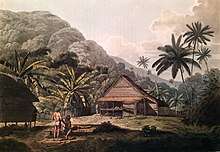
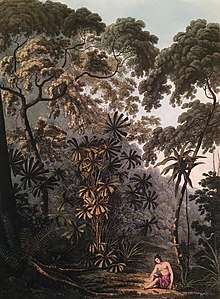
In February 1780, the crews of HMS Resolution (1771) and HMS Discovery (1774), on the way home after Captain James Cook's death in Hawaiʻi, stopped for a few days on Krakatoa. They found a freshwater and a hot spring on the island. They described the natives who then lived on the island as "friendly" and made several sketches (In his journal, John Ledyard calls the island "Cocoterra").
Visit by USS Peacock
Edmund Roberts calls the island Crokatoa in his journal. A paraphrased account follows: On 8 September 1832, US sloop-of war Peacock anchored off the north end, also visiting Lang Island, in search of inhabitants, fresh water, and yams. It was found difficult to land anywhere, due to a heavy surf and to the coral having extended itself to a considerable distance from the shore. Hot springs boiling furiously up, through many fathoms of water, were found on the eastern side of Krakatoa, 150 feet (46 m) from the shore. Roberts, Captain Geisinger, and marine lieutenant Fowler visited Forsaken island, having mistaken the singing of locusts for the sound of running water. The boat glided over crystal clear water, over an extensive and highly beautiful submarine garden. Corals of every shape and hue were there, some resembling sunflowers and mushrooms, others cabbages from 1 to 36 inches (3 to 91 cm) in diameter, while a third type bore a striking likeness to the rose. The hillsides were typical of tropical climate; large flocks of parrots, monkeys in great variety, wild-mango and orange groves—a superb scene of plants and flowers of every description, glowing in vivid tints of purple, red, blue, brown, and green—but not water or provisions.[24]
Dutch activity
In 1620, the Dutch set up a naval station on the islands and somewhat later a shipyard was built. Sometime in the late 17th century, an attempt was made to establish a pepper plantation on Krakatoa, but the islands were generally ignored by the Dutch East India Company. In 1809, a penal colony was established at an unspecified location, which was in operation for about a decade. By the 1880s, the islands were without permanent inhabitants; the nearest settlement was the nearby island of Sebesi (about 12 km or 7.5 mi away) with a population of 3,000.
Several surveys and mariners' charts were made, and the islands were little explored or studied. An 1854 map of the islands was used in an English chart, which shows some difference from a Dutch chart made in 1874. In July 1880, Rogier Verbeek made an official survey of the islands, but was only allowed to spend a few hours there. He was able to collect samples from several places, and his investigation later proved important in judging the geological impact of the 1883 eruption.[25]:9
1883 eruption
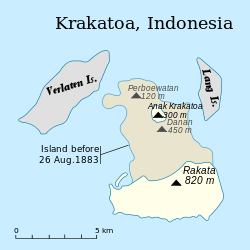
While seismic activity around the volcano was intense in the years preceding the cataclysmic 1883 eruption, a series of lesser eruptions began on 20 May 1883. The volcano released huge plumes of steam and ash lasting until late August.[26]
On 27 August, a series of four huge explosions almost entirely destroyed the island. The explosions were so violent that they were heard 3,110 km (1,930 mi) away in Perth, Western Australia, and the island of Rodrigues near Mauritius, 4,800 km (3,000 mi) away.[5] The pressure wave from the third and most violent explosion was recorded on barographs around the world.[27] Several barographs recorded the wave seven times over the course of five days: four times with the wave travelling away from the volcano to its antipodal point, and three times travelling back to the volcano;[25]:63 the wave rounded the globe three and a half times. Ash was propelled to a height of 80 km (260,000 ft). The sound of the eruption was so loud it was reported that if anyone was within 16 kilometres (10 mi), they would have gone deaf.
The combined effects of pyroclastic flows, volcanic ashes, and tsunamis had disastrous results in the region and worldwide. The death toll recorded by the Dutch authorities was 36,417, although some sources put the estimate at more than 120,000. There are numerous documented reports of groups of human skeletons floating across the Indian Ocean on rafts of volcanic pumice and washing up on the east coast of Africa up to a year after the eruption. Summer temperatures in the northern hemisphere fell by an average of 0.4 °C (0.72 °F) in the year following the eruption.[28]
Aftermath
Anak Krakatau
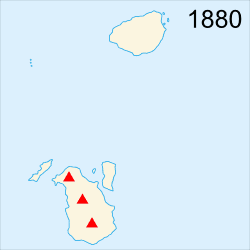
Verbeek, in his report on the eruption, predicted that any new activity would manifest itself in the region which had been between Perboewatan and Danan. This prediction came true on 29 December 1927, when a submarine lava dome in the area of Perboewatan showed evidence of eruptions (an earlier event in the same area had been reported in June 1927). A new island volcano rose above the waterline a few days later. The eruptions were initially of pumice and ash, and that island and the two islands that followed were quickly eroded away by the sea. Eventually, a fourth island, named Anak Krakatau (meaning "child of Krakatoa" in Indonesian), broke water in August 1930 and produced lava flows more quickly than the waves could erode them.
Biological research
The islands have become a major case study of island biogeography and founder populations in an ecosystem being built from the ground up in an environment virtually cleaned.[29]
The islands had been little studied or biologically surveyed before the 1883 catastrophe—only two pre-1883 biological collections are known: one of plant specimens and the other part of a shell collection. From descriptions and drawings made by HMS Discovery, the flora appears to have been representative of a typical Javan tropical climax forest. The pre-1883 fauna is virtually unknown, but was probably typical of the smaller islands in the area.
Botanical studies
From a biological perspective, the Krakatau problem[30] refers to the question of whether the islands were completely sterilized by the 1883 eruption or whether some indigenous life survived. When the first researchers reached the islands in May 1884, the only living thing they found was a spider in a crevice on the south side of Rakata. Life quickly recolonized the islands, however; Verbeek's visit in October 1884 found grass shoots already growing. The eastern side of the island has been extensively vegetated by trees and shrubs, presumably brought there as seeds washed up by ocean currents or carried in birds' droppings (or brought by natives and scientific investigators). It is, however, in a somewhat fragile position, and the vegetated area has been badly damaged by recent eruptions.
Handl's occupancy
A German, Johann Handl, obtained a permit to mine pumice in October 1916.[20] His lease of 8.7 square kilometres (3.4 sq mi) (basically the eastern half of the island), was to be for 30 years. He occupied the south slope of Rakata from 1915 to 1917, when he left due to "violation of the terms of the lease." (According to Winchester, Handl arrived in 1917 and stayed there for four years.) Handl built a house and planted a garden with "four European families and about 30 coolies". It is his party that is believed to have inadvertently introduced the black rat to the island. Handl found un-burned wood below the 1883 ash deposits while digging, and fresh water was found below 5.5 metres (18 ft).
Popular culture

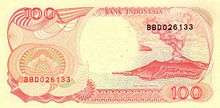
A large part of the 1947 children's novel The Twenty-One Balloons by William Pene du Bois takes place on Krakatoa, where several families have established a wealthy and fanciful colony based on fictional diamond mines on the island.
Krakatoa has been featured as a subject and a part of the story in various television and film dramas. In the 1953 film Fair Wind to Java, an American sea captain and a pirate leader race one another to recover a fortune in diamonds hidden on Krakatoa, which begins its final eruption as they search the island for the treasure.[32] The island was a prominent part of the plot of '"Crack of Doom," episode six of the Irwin Allen television series The Time Tunnel in 1966. It was also featured as the main part of the story line in the 1969 film, Krakatoa, East of Java (retitled Volcano in a re-release in the 1970s; the title contains a rather large geographical error, as Krakatoa is west of Java), which depicts an effort to salvage a priceless cargo of pearls located perilously close to the erupting volcano. An Indonesian martial arts action film, Krakatau (1977), starring Dicky Zulkarnaen and Advent Bangun, also set the story on the mountain. In more recent years, it has been the subject of a 2006 television drama, Krakatoa: Volcano of Destruction and again in 2008 as Krakatoa.
In Klaus Teuber's board game Seafarers of Catan, the "Krakatoa Variant" is a scenario involving an island composed of three volcano tiles.[33]
In 1973, the American progressive rock band Styx released a spoken-word track called "Krakatoa" on its album The Serpent Is Rising. Written by then-guitarist John Curulewski along with Paul Beaver and Bernie Krause, the song tells the story of Krakatoa's eruption and the subsequent return of life to the island.
The British heavy metal band Saxon also released a song about the 1883 eruption of Krakatoa, called "Krakatoa", on the 2010 re-release of its 1985 album Innocence Is No Excuse.
See also
References
Citations
- "Global Volcanism Program | Krakatau". Smithsonian Institution | Global Volcanism Program.
- "Global Volcanism Program | Krakatau". volcano.si.edu.
- Breining, Greg (2007). "The Deadliest Volcanoes". Super Volcano: The Ticking Time Bomb Beneath Yellowstone National Park. Voyageur Press. p. 256. ISBN 978-0-7603-2925-2.
- Hopkinson, Deborah (January 2004). "The Volcano That Shook the World: Krakatoa 1883". 11 (4). New York: Storyworks: 8. Cite journal requires
|journal=(help) - "How Krakatoa made the biggest bang". The Independent. London. 3 May 2006. Archived from the original on 29 July 2018. Retrieved 22 August 2018.
- "Anak Krakatau". Retrieved 10 November 2011.
- "Krakatau". Global Volcanism Program. Smithsonian Institution.
- Donahue, Terry (5 December 2017). "The Resurrection Of Krakatau". The Indonesia Expat. Indonesiaexpat.biz. Retrieved 29 December 2018.
- Amos, Jonathan (29 December 2018). "Indonesian volcano's lost stature". BBC News. Retrieved 29 December 2018.
- Winchester 2003, p. 27.
- Note:The main theories are:
- Onomatopoeia, imitating the noise made by cockatoos (Kakatoes) which used to inhabit the island. However, Van den Berg points out that these birds are found only in the "eastern part of the archipelago" (meaning the Lesser Sundas, east of Java, on the other side of the Wallace Line).
- From Sanskrit karka or karkata or karkataka, meaning "lobster" or "crab". (Rakata also means "crab" in the older Javan language.) This is considered the most likely origin.
- The closest Malay word is kelakatu, meaning "white-winged ant". Furneaux points out that in pre-1883 maps, Krakatoa does somewhat resemble an ant seen from above, with Lang and Verlaten lying to the sides like wings.
- Van den Berg (1884) recites a story that Krakatau was the result of a linguistic error. According to the legend, a visiting ship's captain asked a local inhabitant the island's name, and the latter replied, "Kaga tau" (Aku enggak tahu)—a Jakartan/Betawinese slang phrase meaning "I don't know". This story is largely discounted; it closely resembles other linguistic myths about the origin of the word kangaroo and the name of the Yucatán Peninsula.
- Note: This spelling has been attributed to a sub-editor at The Times (who may have typographically swapped the 'a' and 'o' of the Portuguese spelling) interpreting telegraphic reporting on the massive eruption of 1883.
- Winchester 2003, p. 183.
- "Volcanoes of Indonesia". Global Volcanism Program. Smithsonian Institution. Retrieved 25 March 2007.
- Note: apparently because it looked like a hat from the sea
- Note: The dating of these events is currently unknown. The Sunda Strait was first mentioned by Arab sailors circa 1100.
- "Krakatau version 1.0, Part 2". The Anthropogene. 11 November 2003. Archived from the original on 28 May 2010. Retrieved 23 January 2010.
- Wohletz, K. H. (2000). "Were the dark ages triggered by volcano-related climate changes in the 6th century". Eos, Transactions American Geophysical Union. 48 (81): F1305. Retrieved 21 June 2018.
- "The eruption of Krakatoa, August 27, 1883". Commonwealth of Australia 2012, Bureau of Meteorology. Archived from the original on 18 March 2016. Retrieved 5 April 2012.
- Thornton, Ian (1997). Krakatau: the destruction and reassembly of an island ecosystem (1st ed.). Cambridge, MA: Harvard University Press. ISBN 978-0674505728.
- Note: Vogel returned to Amsterdam in 1688 and published the first edition of his journal in 1690.
- Winchester 2003, pp. 132–133.
- Note: Historians Van den Berg and Verbeek both conclude that Vogel must have exaggerated the extent of the eruption he saw. Even so, there must have been an eruption around this time.
- Roberts, Edmund (12 October 2007) [1837]. "Chapter III; Arrival at Crokatoa and Forsaken Islands". Embassy to the Eastern courts of Cochin-China, Siam, and Muscat : in the U. S. sloop-of-war Peacock ... during the years 1832–3–4. Harper & brothers. Digital images 46–48.
- Symons, G.J. (ed) The Eruption of Krakatoa and Subsequent Phenomena (Report of the Krakatoa Committee of the Royal Society). London, 1888. London, Trübner & co. 1 April 2008. Retrieved 5 May 2015.
- Winchester 2003, pp. 154–166.
- Monique R. Morgan (January 2013). "The Eruption of Krakatoa (also known as Krakatau) in 1883". BRANCH: Britain, Representation and Nineteenth-Century History. Retrieved 5 February 2019.
- Bradley, Raymond S. (June 1988). "The explosive volcanic eruption signal in northern hemisphere continental temperature records" (PDF). Climatic Change. 12 (3): 221–243. Bibcode:1988ClCh...12..221B. doi:10.1007/bf00139431. ISSN 0165-0009 – via Springer.
- Wilson, Edward. O. (1999). The Diversity of Life. New York: W.W. Norton & Company. p. 425. ISBN 978-0-393-31940-8.
- Backer, Cornell's Andries (1929). The Problem of Krakatau, as Seen by a Botanist. author, at Weltevreden, Java.
- "Krakatoa provided backdrop to Munch's scream". The Age. Melbourne. Reuters. 11 December 2003. Retrieved 15 November 2010.; "Why the sky was red in Munch's 'The Scream'". CNN. Reuters. 10 December 2003. Retrieved 15 November 2010. Cite journal requires
|journal=(help); Panek, Richard (8 February 2004). "'The Scream,' East of Krakatoa". The New York Times. Retrieved 15 November 2010. - tcm.com Fair Wind to Java (1953) Overview
- "Krakatoa Bay". Catan Maps. Retrieved 2 May 2015.
Bibliography
See Krakatoa documentary and historical materials
- Winchester, Simon (2003). Krakatoa: The Day the World Exploded: August 27, 1883. New York: HarperCollins. ISBN 978-0-06-083859-1.CS1 maint: ref=harv (link)
External links
| Wikimedia Commons has media related to Krakatoa. |
- 1883 Eruption of Krakatau from the United States Geological Survey's Cascades Volcano Observatory
- Krakatau, Indonesia (1883) – information from San Diego State University about the 1883 eruption
- Krakatoa – The Great Volcanic Eruption on YouTube – "Naked Science"
- Bani, Philipson; Normier, Adrien; Bacri, Clémentine; Allard, Patrick; Gunawan, Hendra; Hendrasto, Muhammad; Surono; Tsanev, Vitchko (2015), "First measurement of the volcanic gas output from Anak Krakatau, Indonesia", Journal of Volcanology and Geothermal Research, 302: 237–241, Bibcode:2015JVGR..302..237B, doi:10.1016/j.jvolgeores.2015.07.008